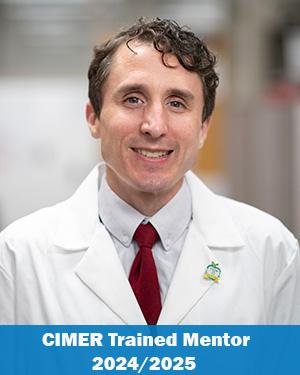Research News
06/04/2021
Late-Life Fasting Revealed to Improve Health of Preclinical Models
Dr. Hine discovered that every-other-day fasting helped improve metabolic, muscular and cognitive fitness among aged preclinical models, suggesting possible utility as a clinical intervention to increase healthy years and prevent or delay cognitive decline.

Late-life initiated dietary restriction has been shown to reduce aging-related frailty and extend healthspan, according to preclinical study findings from researchers in the Department of Cardiovascular & Metabolic Sciences.
“Humans are living longer, which is great. But what we’re finding is that although life expectancy has increased, people are not necessarily living that entire time in good health,” said Christopher Hine, PhD, lead researcher on the study published in Geroscience.
There is a growing body of evidence that among animal models, dietary restriction enhances health and increases lifespan. These benefits have not been fully realized in patients, however, because compliance to strict dietary regimens is more difficult in people.
Adherence: A critical requirement for dietary interventions
In this study, Dr. Hine and his team tested a more clinically applicable regimen in mice. They found that late-life initiated every-other-day (EOD) fasting had significant metabolic, musculoskeletal and cognitive benefits for male models.
“In clinical practice, even the most effective therapeutic interventions only work if patients adhere to them. We believe that EOD fasting is more attainable than daily dietary restriction,” said Dr. Hine. “We have yet to test this intervention in patients, but are optimistic about the positive findings in preclinical models.”
The researchers compared the effects of two dietary regimens on several indicators of frailty, which researchers that study aging have found to be a more accurate predictor of mortality than chronological age. Beginning in late life, groups had either unrestricted access to a standard diet every day or cycled between days of fasting and unrestricted access to the same standard diet.
Every-other-day fasting improves frailty indicators, extends healthspan
Dr. Hine and his team found that the benefits of EOD fasting were primarily seen in male mice. EOD fasting reduced overall energy intake, body weight and fat mass. It also enhanced several indicators of frailty, including metabolic fitness, muscular functions and some cognitive functions.
According to Dr. Hine, cognitive performance has not been widely tested in other preclinical studies related to dietary restriction and aging. “We found that late-life initiated EOD fasting led to improved performance on two cognitive tests related to hippocampus-dependent memory—the type of memory involved in spatial memory and consolidating short-term memory to long-term memory.”
Alzheimer’s disease and other dementias are typically related to age. Additional research is necessary, but these findings offer important insights into dietary intervention as a potential approach to improve healthspan and prevent cognitive impairment in patients.
A possible source for the sex-based differences in healthspan benefits
Looking for a biological explanation as to why primarily only male mice experienced these health benefits, the researchers found that female mice, but not male mice, overcompensated their food intake on the fed day. EOD fasting also increased levels of the chemical compound hydrogen sulfide in the kidneys of males but not females. Previous research has shown that aging decreases expression and activity of the enzymes that produce the compound.
The findings show that among male mice, higher hydrogen sulfide levels were associated with the greatest improvements in age-related frailty, suggesting the sex-based differences may be modulated in part by the compound’s production. Dr. Hine and his team recently published findings in Nature Communications from a companion study that took a closer look at the molecular changes caused by EOD fasting and caloric restriction.
Dietary restriction alters hydrogen sulfide levels
Hydrogen sulfide is involved in many critical biochemical reactions in the body and sends signals through a process called protein persulfidation. According to Dr. Hine, persulfidated proteins have an altered chemical structure that is easy to recognize. “We measured the levels of persulfidated proteins in various tissues throughout our EOD fasting preclinical models and compared expression levels with models fed an unrestricted diet.”
Like their earlier findings, the researchers showed that dietary restriction increased levels of hydrogen sulfide. They also found EOD fasting increased levels of an enzyme involved in hydrogen sulfide production (called cystathionine γ-lyase).
Protein persulfidation was enriched in several organs—including the liver, kidney, muscle and brain—of both young and old mice under EOD fasting and caloric restriction, and particularly abundant in cellular pathways known to be involved in metabolic health and aging. Mice lacking the enzyme that produces hydrogen sulfide had significantly reduced levels of persulfidated proteins, which were not rescued even following dietary restriction.
Taken together, the team’s findings suggest that dietary restriction increases production capacity of hydrogen sulfide, which is suspected to confer metabolic and aging-related benefits. The researchers’ next steps will be to investigate the specific downstream effects of protein persulfidation and if they can be targeted, opening the door for both dietary and therapeutic interventions to prevent aging-related decline and extend lifespan.
Yoko Henderson, PhD, a postdoctoral fellow in Dr. Hine’s lab, is first author on the Geroscience study, which was funded in part by the National Institute on Aging (NIA) and the National Heart, Lung, and Blood Institute (NHLBI)—both parts of the National Institutes of Health. Nazmin Bithi, a graduate student in Dr. Hine’s lab, is first author on the Nature Communications study, which was also funded by NIA and NHLBI.
Featured Experts
News Category
Related News
Research areas
Want To Support Ground-Breaking Research at Cleveland Clinic?
Discover how you can help Cleveland Clinic save lives and continue to lead the transformation of healthcare.
Give to Cleveland Clinic